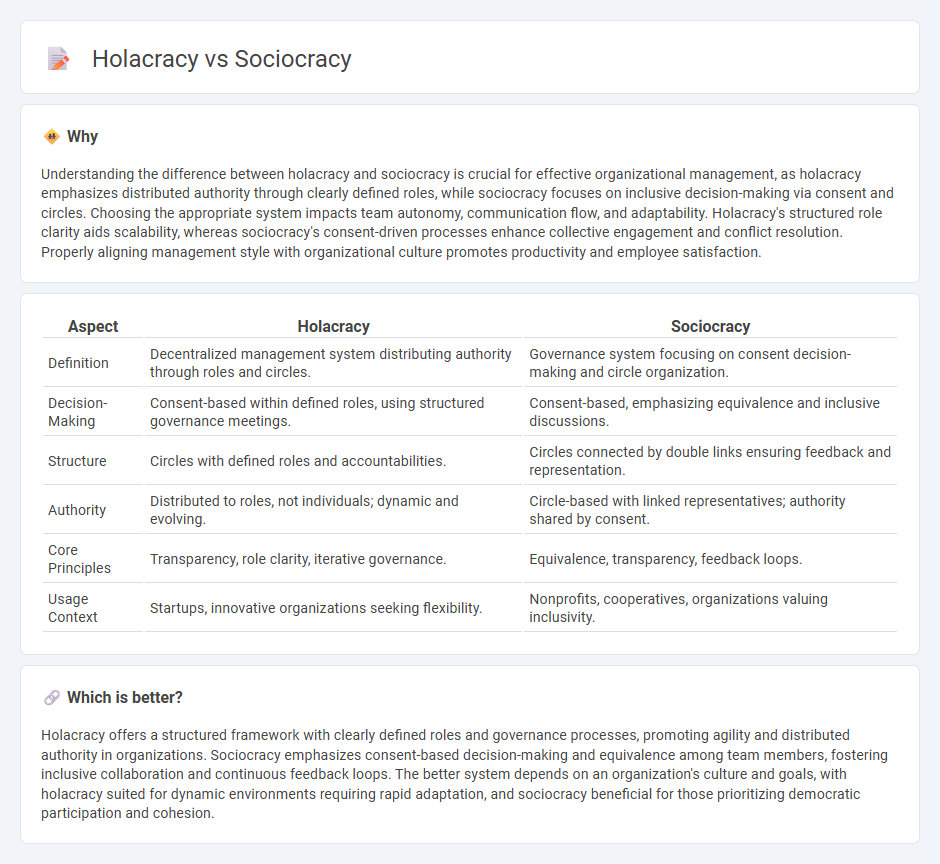
Holacracy and sociocracy are innovative management systems designed to enhance organizational agility and employee engagement by distributing decision-making authority throughout the company structure. Holacracy emphasizes roles and circles with defined responsibilities governed by formal rules, while sociocracy focuses on consent-based decision-making and continuous feedback loops within linked circles. Explore more to understand how these approaches redefine leadership and operational efficiency.
Why it is important
Understanding the difference between holacracy and sociocracy is crucial for effective organizational management, as holacracy emphasizes distributed authority through clearly defined roles, while sociocracy focuses on inclusive decision-making via consent and circles. Choosing the appropriate system impacts team autonomy, communication flow, and adaptability. Holacracy's structured role clarity aids scalability, whereas sociocracy's consent-driven processes enhance collective engagement and conflict resolution. Properly aligning management style with organizational culture promotes productivity and employee satisfaction.
Comparison Table
| Aspect | Holacracy | Sociocracy |
|---|---|---|
| Definition | Decentralized management system distributing authority through roles and circles. | Governance system focusing on consent decision-making and circle organization. |
| Decision-Making | Consent-based within defined roles, using structured governance meetings. | Consent-based, emphasizing equivalence and inclusive discussions. |
| Structure | Circles with defined roles and accountabilities. | Circles connected by double links ensuring feedback and representation. |
| Authority | Distributed to roles, not individuals; dynamic and evolving. | Circle-based with linked representatives; authority shared by consent. |
| Core Principles | Transparency, role clarity, iterative governance. | Equivalence, transparency, feedback loops. |
| Usage Context | Startups, innovative organizations seeking flexibility. | Nonprofits, cooperatives, organizations valuing inclusivity. |
Which is better?
Holacracy offers a structured framework with clearly defined roles and governance processes, promoting agility and distributed authority in organizations. Sociocracy emphasizes consent-based decision-making and equivalence among team members, fostering inclusive collaboration and continuous feedback loops. The better system depends on an organization's culture and goals, with holacracy suited for dynamic environments requiring rapid adaptation, and sociocracy beneficial for those prioritizing democratic participation and cohesion.
Connection
Holacracy and sociocracy are interconnected governance systems emphasizing decentralized decision-making and collective autonomy within organizations. Both frameworks use structured processes like consent-based decision-making and self-organizing teams to enhance transparency and distribute authority evenly. These methods aim to increase organizational agility by fostering inclusive participation and reducing hierarchical bottlenecks in management.
Key Terms
Consent Decision-Making (Sociocracy)
Sociocracy emphasizes consent decision-making, ensuring that decisions proceed only when no member has a paramount objection, fostering inclusive participation and continuous feedback to improve group dynamics. Unlike majority voting, consent prioritizes collaborative problem-solving and effective governance by integrating diverse perspectives while minimizing conflicts. Explore how consent decision-making enhances organizational agility and cohesion.
Governance Circles (Holacracy)
Governance Circles in Holacracy function as self-organizing units where members define roles, policies, and accountabilities collaboratively to enhance decentralized decision-making. Unlike Sociocracy, which uses consent-based decision rules focusing on equivalence and feedback loops, Holacracy's circles emphasize structured role clarity and tactical meetings to streamline governance. Explore the distinct mechanisms within Governance Circles to understand how Holacracy transforms organizational governance.
Distributed Authority
Sociocracy emphasizes distributed authority through consent-based decision-making, ensuring that every circle or group has equal voice and clear double-linking between levels for effective coordination. Holacracy distributes authority using structured roles and governance meetings to dynamically assign decision-making power, aiming for agility and responsiveness. Explore the nuances of these systems to understand which decentralized governance model best fits your organization.
Source and External Links
What Is Sociocracy and Why Does Democracy Need it? - Explains sociocracy as a system combining organizational methods with social ideals, emphasizing equality and consent-based decision-making.
Sociocracy - Describes sociocracy as a theory of governance that uses consent for decision-making, aiming to create productive and psychologically safe environments.
Sociocracy - Introduces sociocracy as a governance system suited for self-governing organizations based on equality, using consent and dynamic governance principles.
 dowidth.com
dowidth.com